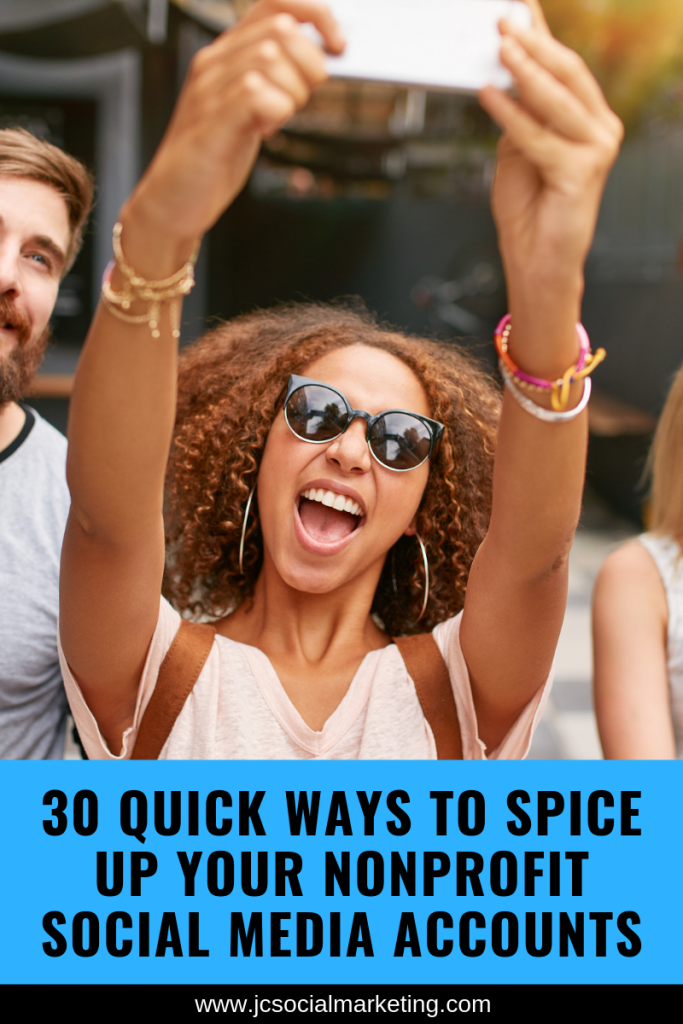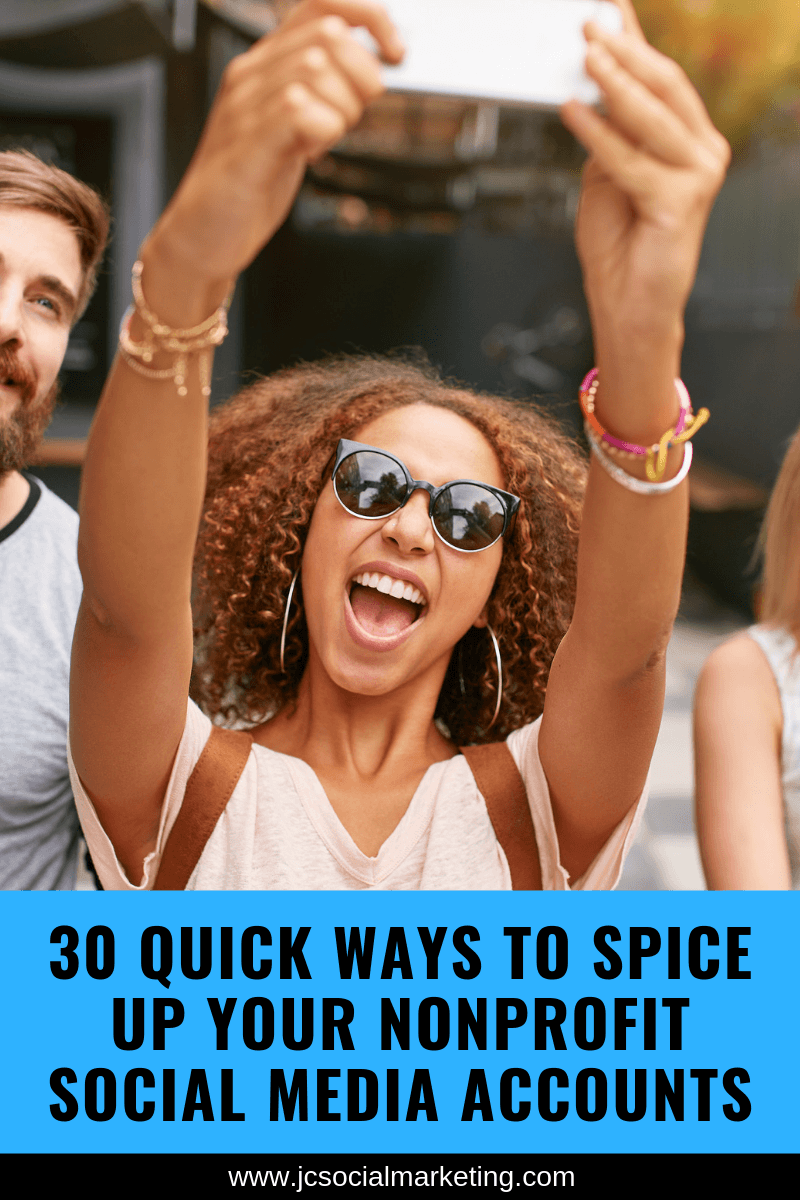 Spring is here (well, maybe not in Boston but everywhere else)!
Spring is here (well, maybe not in Boston but everywhere else)!
With it comes new energy, fresh ideas, and the motivation to try new things – on your nonprofit social media accounts!
If you want to dust off the cobwebs, open the windows, and get rid of the crickets, here are 30 different things you can try that will spice up your accounts.
The best feature of this social media menu is that even small shop nonprofit social media managers can carry these out on a shoestring budget.
Read, select, prioritize, pick, choose, implement! Let’s get started.
Facebook:
- Post more video. Video posts on Facebook receive 59% more engagement on average that any other kind of post. Take out that smartphone and document a day in the life of your organization in short, 10 second video clips.
- Start a Facebook Group. Facebook Groups are organized around issues, topics, and identities rather than brands and organizations. Groups function as specific communities of people who interact directly with each other rather than through the middleman of a Page. Nonprofits can use Groups to create a forum for feedback, host discussions, and provide a select group of people with exclusive content.
- Go live on Facebook. Use Facebook Live when you want to broadcast from events or activities and interact with your supporters in real time. You can field their questions, read their comments, and share powerful stories with your community as they unfold.
- Share educational info. How To posts, Top 10 lists, educational graphics, and thought-provoking articles about the issue you are solving will help you increase trust and build your community on Facebook.
- Explore Messenger Chatbots. Chatbots aren’t the future, they are being used daily on Facebook. Nonprofits are using chatbots to answer basic inquiries, to activate supporters around in-the-moment advocacy actions, and to build up email lists. Beth Kanter curates a great list of nonprofit chatbots: Nonprofits and Bots
Twitter:
- Tweet more video. According to Twitter’s online video playbook, videos are 6x more likely to be retweeted than photos and 3x more likely to be retweeted than tweets with GIFs.
- Research relevant hashtags. Use Twitter itself or a platform like Hashtags.org to find out what’s being used around your cause. You may think that #endfur is a great hashtag, but if everyone is using #stopfur, then you will missing a chance for exposure.
- Share useful tips. Twitter is a great place to find and curate educational articles and information with your audience. Be The Match uses Twitter to dispel myths and misconceptions that people may have about donating bone marrow:
- Join a TweetChat. Twitter chats exist on any and all topics and issues. I recommend being an active participant in several TweetChats before starting your own, which can be time-consuming to promote and maintain. Instead, explore and participate in other TweetChats around the issues that you are working on.
- Use Twitter Lists to your advantage. You don’t have to officially follow a Twitter user to put them on one of your Lists! Lists can be public or private. They are a great way to turn off the Twitter feed firehose and display only the tweets that you want to see, grouped together. Creating such a list saves time and creates community because people will appreciate being added to your public lists.
Instagram:
- Show your human face. If your Executive Director or other spokesperson is willing and able to set up and maintain a personal Instagram account, by all means, encourage this! People prefer to connect with people on social media, much more than brands and logos. Having a personalized presence can increase your reach on Instagram and create deeper connections with donors and supporters. For example, TOMS shoes and their founder and social entrepreneur Blake Mycoskie maintain separate Instagram accounts, showcasing different visual styles and points of view. International nonprofit Pencils of Promise and their founder Adam Braun also have separate, but complementary, Instagram accounts.
- Tell stories. Instagram is one of the best platforms for visual storytelling. Feature staff, volunteers, donors, clients, community partners in your stories. Highlight one person or a very small group at a time and write a longer caption (2200 character max) to get more engagement.
- Be real. For example, @doctorswithoutborders consistently shows the good, the bad, and the ugly in international development work, not afraid to share images that are often hard to look at but are breathtaking in scope;
- Use Instagram Stories. Stories allows users to share many moments during their day in one cohesive story that disappears after 24 hours. Since they don’t stay permanently on your profile, they are perfect for in-the-moment happenings and events that need to be documented as they happen. The benefit of this type of content is that you can experiment and share video and photos with your followers that doesn’t fit the carefully cultivated visual style of your overall Instagram account.
- Increase your followers with hashtags. Track Maven reported that posts with more than 11 hashtags get the most engagement. When choosing which hashtags to use on your particular photo, research what others use on similar posts, and what hashtags make the most sense for your nonprofit and your mission.
YouTube:
- Add closed captions. 85% of social media videos are watched without sound. In addition, adding subtitles and closed captions make your videos accessible to a wider audience, and those with hearing impairments.
- Create custom thumbnails for your videos. 90% of the most-watched videos have custom thumbnails. Use a graphic design tool like Canva.com or Adobe Spark to get free templates.
- Remove ads. To remove advertisements that play before their videos, nonprofits need to register with YouTube for Nonprofits.
- Add clickable links. Direct viewers to external websites with Link Anywhere cards, a special card type that lets you to link to any external URL. You can create call-to-action overlays for your videos, which appear as soon as the video begins to play. When users click on the overlay, they’re directed to your external website.
- Publish your PowerPoint slide deck as a video. If you have a report, announcement, or a presentation that can be converted to PowerPoint, you can create a video file from the slide show and upload the video to YouTube.
LinkedIn:
- Publish on LinkedIn. LinkedIn has a built in publishing platform where you can share long-form posts, blogs, announcements, videos, and more.
- Share video. Video is not as widely shared on LinkedIn, so it’s still a big way to stand out and grab attention. You can share video inside your profile, in your published posts in LinkedIn Publisher, or in your status updates.
- Make your Company Page pop. So many Company Pages on LinkedIn are bland and boring. Add colorful, emotive channel art to your Page and share stories that resonate.
- Budget for Sponsored Updates. Sponsored updates allow you to show your posts to new audiences.The best part is LinkedIn’s robust audience targeting, which allows you to select who sees your posts by skills, job title, region, industry, and more.
- Make yourself findable. Beyond your nonprofit’s official Company Page, it’s important on a professional networking site like LinkedIn that employees make themselves accessible and discoverable. Do this by including relevant keywords in your headline, adding your city, and inserting samples of your work into your profile.
Pinterest:
- Create Pinterest boards around your services. Think of animal advocates posting photos of pet care items and people happy with their pets.
- Share helpful resources. These could be in the form of how-to videos from youTube or Vimeo, articles, news, infographics, white papers, webinars, podcasts – anything and everything that your audience would be interested in.
- Collect impact stories and visuals of your work. After school programs could post photos of art projects, camps could share videos of outdoor activities. Agencies could pin pictures of beds, kitchens, clothing and other comforts.
- Ask for support with a specific wishlist. Food banks could share photos of the items that they most need and want in each season.
- Curate a vision board. Your vision board would represent the future that you seek to create: Domestic violence programs posting photos that represent happiness, safety and support.
Let me know what you would add – leave your ideas in the comments!
